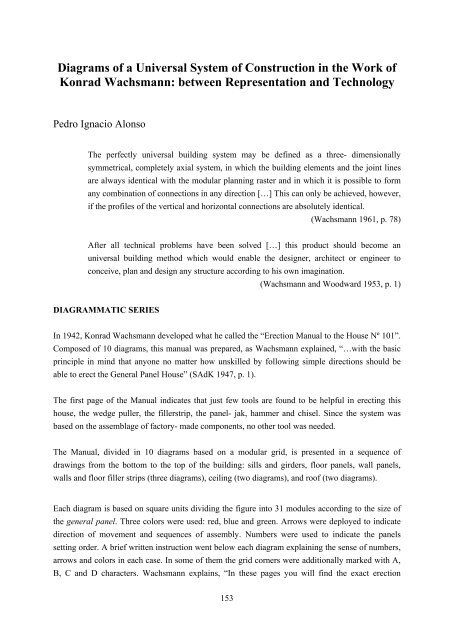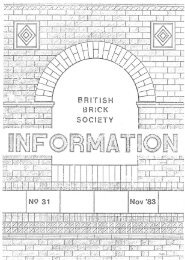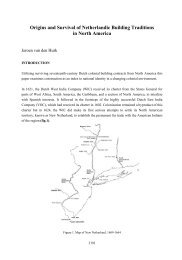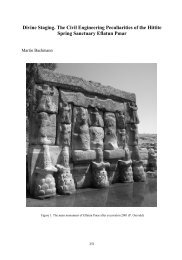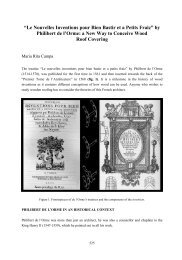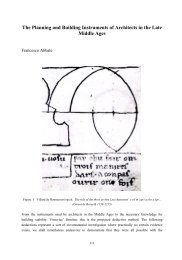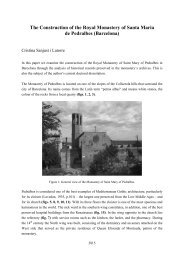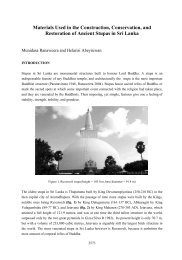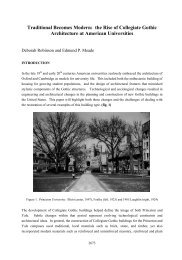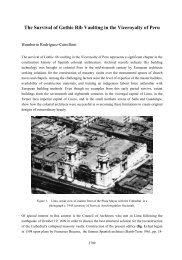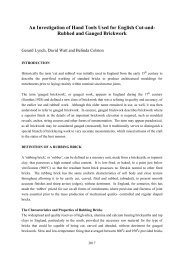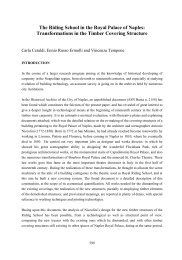Diagrams of a Universal System of Construction in
Diagrams of a Universal System of Construction in
Diagrams of a Universal System of Construction in
You also want an ePaper? Increase the reach of your titles
YUMPU automatically turns print PDFs into web optimized ePapers that Google loves.
<strong>Diagrams</strong> <strong>of</strong> a <strong>Universal</strong> <strong>System</strong> <strong>of</strong> <strong>Construction</strong> <strong>in</strong> the Work <strong>of</strong><br />
Konrad Wachsmann: between Representation and Technology<br />
Pedro Ignacio Alonso<br />
The perfectly universal build<strong>in</strong>g system may be def<strong>in</strong>ed as a three- dimensionally<br />
symmetrical, completely axial system, <strong>in</strong> which the build<strong>in</strong>g elements and the jo<strong>in</strong>t l<strong>in</strong>es<br />
are always identical with the modular plann<strong>in</strong>g raster and <strong>in</strong> which it is possible to form<br />
any comb<strong>in</strong>ation <strong>of</strong> connections <strong>in</strong> any direction […] This can only be achieved, however,<br />
if the pr<strong>of</strong>iles <strong>of</strong> the vertical and horizontal connections are absolutely identical.<br />
(Wachsmann 1961, p. 78)<br />
After all technical problems have been solved […] this product should become an<br />
universal build<strong>in</strong>g method which would enable the designer, architect or eng<strong>in</strong>eer to<br />
conceive, plan and design any structure accord<strong>in</strong>g to his own imag<strong>in</strong>ation.<br />
(Wachsmann and Woodward 1953, p. 1)<br />
DIAGRAMMATIC SERIES<br />
In 1942, Konrad Wachsmann developed what he called the “Erection Manual to the House Nº 101”.<br />
Composed <strong>of</strong> 10 diagrams, this manual was prepared, as Wachsmann expla<strong>in</strong>ed, “…with the basic<br />
pr<strong>in</strong>ciple <strong>in</strong> m<strong>in</strong>d that anyone no matter how unskilled by follow<strong>in</strong>g simple directions should be<br />
able to erect the General Panel House” (SAdK 1947, p. 1).<br />
The first page <strong>of</strong> the Manual <strong>in</strong>dicates that just few tools are found to be helpful <strong>in</strong> erect<strong>in</strong>g this<br />
house, the wedge puller, the fillerstrip, the panel- jak, hammer and chisel. S<strong>in</strong>ce the system was<br />
based on the assemblage <strong>of</strong> factory- made components, no other tool was needed.<br />
The Manual, divided <strong>in</strong> 10 diagrams based on a modular grid, is presented <strong>in</strong> a sequence <strong>of</strong><br />
draw<strong>in</strong>gs from the bottom to the top <strong>of</strong> the build<strong>in</strong>g: sills and girders, floor panels, wall panels,<br />
walls and floor filler strips (three diagrams), ceil<strong>in</strong>g (two diagrams), and ro<strong>of</strong> (two diagrams).<br />
Each diagram is based on square units divid<strong>in</strong>g the figure <strong>in</strong>to 31 modules accord<strong>in</strong>g to the size <strong>of</strong><br />
the general panel. Three colors were used: red, blue and green. Arrows were deployed to <strong>in</strong>dicate<br />
direction <strong>of</strong> movement and sequences <strong>of</strong> assembly. Numbers were used to <strong>in</strong>dicate the panels<br />
sett<strong>in</strong>g order. A brief written <strong>in</strong>struction went below each diagram expla<strong>in</strong><strong>in</strong>g the sense <strong>of</strong> numbers,<br />
arrows and colors <strong>in</strong> each case. In some <strong>of</strong> them the grid corners were additionally marked with A,<br />
B, C and D characters. Wachsmann expla<strong>in</strong>s, “In these pages you will f<strong>in</strong>d the exact erection<br />
153
sequence <strong>of</strong> all members <strong>in</strong> the system” (1947, p.1) In fact, despite <strong>of</strong> the existence <strong>of</strong> conventional<br />
draw<strong>in</strong>gs, the whole structure could be deduced and built by us<strong>in</strong>g the Erection Manual alone. S<strong>in</strong>ce<br />
the Manual <strong>in</strong>dicates assembly sequences, Wachsmann considered that time and movement were<br />
<strong>in</strong>tegrated <strong>in</strong> a diagrammatic representation <strong>of</strong> a universal system <strong>of</strong> construction.<br />
Figure 1. Erection Manual, 1947 (Stiftung Archiv der Akademie der Künste, Berl<strong>in</strong>)<br />
Figure 2. Erection Manual, page 6 (Walls and Floor filler Strips) and page 7 (Ceil<strong>in</strong>g)<br />
(Stiftung Archiv der Akademie der Künste, Berl<strong>in</strong>)<br />
154
Complementary to this manual, Wachsmann developed a series <strong>of</strong> 13 numbered diagrams which<br />
were later published <strong>in</strong> “The Turn<strong>in</strong>g Po<strong>in</strong>t <strong>of</strong> Build<strong>in</strong>g, Structure and Design” (1961), the English<br />
translation <strong>of</strong> the earlier German edition edited by Krausskopf <strong>in</strong> 1959. The purpose <strong>of</strong> this book, as<br />
Wachsmann expla<strong>in</strong>ed, was writ<strong>in</strong>g an <strong>in</strong>troductory study <strong>of</strong> the contemporary problems <strong>in</strong><br />
build<strong>in</strong>g, “given the several <strong>in</strong>quiries <strong>of</strong> students, colleagues and friends about the subject”<br />
(Wachsmann 1961, p. 6).<br />
Figure 3. 13 <strong>Diagrams</strong>: Modular coord<strong>in</strong>ation, embrac<strong>in</strong>g movement and time, a system <strong>of</strong> measurement born <strong>of</strong><br />
<strong>in</strong>dustrialization (Wachsmann 1961, p. 59- 61)<br />
Based <strong>in</strong> a three- dimensional modular grid these diagrams correspond to a system <strong>of</strong> representation<br />
<strong>of</strong> an axial system <strong>of</strong> construction. Belong<strong>in</strong>g to the ma<strong>in</strong> tenet proposed by the publication - a new<br />
construction based on the <strong>in</strong>dustrialization <strong>of</strong> build<strong>in</strong>g - these diagrams developed the problem <strong>of</strong><br />
the module and its coord<strong>in</strong>ation. These draw<strong>in</strong>gs illustrate what Wachsmann called “Modular<br />
coord<strong>in</strong>ation, embrac<strong>in</strong>g movement and time, a system <strong>of</strong> measurement born <strong>of</strong> <strong>in</strong>dustrialization”<br />
(1961, p. 56).<br />
155
Wachsmann’s argument is carefully illustrated by the gradual development <strong>of</strong> these 13 diagrams.<br />
Evolv<strong>in</strong>g from the variations <strong>of</strong> a modular grid projected on a plane (based over an assumed<br />
arithmetic progression), a two- dimensional surface is turned <strong>in</strong>to a three- dimensional volume,<br />
stat<strong>in</strong>g a three- dimensional system <strong>of</strong> modular measurement. By detach<strong>in</strong>g the faces <strong>of</strong> the cube<br />
Wachsmann transformed it <strong>in</strong> <strong>in</strong>dependent planes which would be moved and rotated <strong>in</strong> any<br />
direction as the diagram arrows suggest. This was appo<strong>in</strong>ted as the dynamic relationships <strong>of</strong> the<br />
<strong>in</strong>dividual parts obta<strong>in</strong>ed from the subdivided cube. As long as the dimension and movement <strong>of</strong><br />
these planes are simultaneously determ<strong>in</strong>ed, Wachsmann estimates that time is be<strong>in</strong>g additionally<br />
expressed by the diagrams; consequently time was considered <strong>in</strong>dispensable <strong>in</strong> the measurement <strong>of</strong><br />
the module. The spatial <strong>in</strong>terpenetration <strong>of</strong> dynamic planes becomes an abstract center and po<strong>in</strong>t <strong>of</strong><br />
<strong>in</strong>tersection <strong>of</strong> reference planes, volumes and bodies. In such a way, the build<strong>in</strong>g components<br />
<strong>in</strong>volved would be controlled and coord<strong>in</strong>ated by the abstract representation as it conta<strong>in</strong>s the rule<br />
for spatial <strong>in</strong>terpenetrations <strong>in</strong> any possible movement and position. As Wachsmann says, time and<br />
movement were controlled as supplementary ordered system <strong>of</strong> <strong>in</strong>terpenetrat<strong>in</strong>g planes. Such<br />
<strong>in</strong>terpenetration <strong>of</strong> planes was fundamental <strong>in</strong> consider<strong>in</strong>g that the system itself was based on the<br />
notion <strong>of</strong> assemblage.<br />
Figure 4. Diagram Nº 75: Symbol <strong>of</strong> measure, movement and time, <strong>in</strong>to which<br />
any imag<strong>in</strong>ed form can be fitted with<strong>in</strong> the system (Wachsmann 1961, p. 61)<br />
156
Hence, diagram Nº 75 is relevant s<strong>in</strong>ce it becomes “[…] the symbol for measure, movement and<br />
time, <strong>in</strong>to which any imag<strong>in</strong>ed form can be fitted with<strong>in</strong> the system <strong>of</strong> relationships assumed”<br />
(1961, p. 57).<br />
F<strong>in</strong>ally, four diagrams were created to show how this representation <strong>of</strong> <strong>in</strong>terpenetration, time and<br />
movement, would evolve <strong>in</strong>to rastered l<strong>in</strong>es and imag<strong>in</strong>ary elements towards the f<strong>in</strong>al realization <strong>of</strong><br />
an axial system <strong>of</strong> construction. In fact, the last diagram – highlighted on a black background -<br />
conta<strong>in</strong>s a practical application <strong>of</strong> the system, where the <strong>in</strong>terpenetrat<strong>in</strong>g planes would be rotated,<br />
moved and jo<strong>in</strong>ed <strong>in</strong> any desired direction and position by consider<strong>in</strong>g time and movement <strong>in</strong>to the<br />
process <strong>of</strong> construction. This f<strong>in</strong>al diagram, which encloses the basic pr<strong>in</strong>ciples <strong>of</strong> the General<br />
Panel <strong>System</strong>, <strong>in</strong>dicates panels and jo<strong>in</strong>ts <strong>in</strong> any possible situation, either horizontally or vertically.<br />
It clearly shows one <strong>of</strong> the ma<strong>in</strong> purposes <strong>of</strong> such a technical research, the achievement <strong>of</strong> a s<strong>in</strong>gle<br />
way <strong>of</strong> jo<strong>in</strong><strong>in</strong>g, or, <strong>in</strong> Wachsmann’s words, a universal jo<strong>in</strong><strong>in</strong>g technique to connect any component<br />
<strong>in</strong> any desired position and comb<strong>in</strong>ation.<br />
The f<strong>in</strong>al diagram represents the General Panel House as one possible application <strong>of</strong> a wider way <strong>of</strong><br />
th<strong>in</strong>k<strong>in</strong>g expressed <strong>in</strong> such a diagrammatic representation. It proves that Wachsmann’s theoretical<br />
scope was much more ambitious. He sought a general theory <strong>of</strong> construction <strong>in</strong> which the case <strong>of</strong><br />
the General Panel <strong>System</strong> was no other than a specific attempt <strong>of</strong> consummation. Other examples<br />
are found <strong>in</strong> the ARMCO <strong>System</strong> (1953), and <strong>in</strong> the projects developed with students at the<br />
Advanced Build<strong>in</strong>g Research Programme <strong>of</strong> the Ill<strong>in</strong>ois Institute <strong>of</strong> Technology (1950 onwards),<br />
the Salzburg Summer Academy (1957), etc.<br />
Figure 5. General Panel <strong>System</strong> applied to a larger configuration (Stiftung Archiv der<br />
Akademie der Künste, Berl<strong>in</strong>)<br />
157
In fact, for the ARMCO steel structure Wachsmann proposed: “These elements shall be created <strong>in</strong><br />
such a way that one should be able to plan a build<strong>in</strong>g <strong>of</strong> any shape and form beg<strong>in</strong>n<strong>in</strong>g from a one-<br />
story structure to the unlimited height skyscraper” (SAdK 1953. p. 1), <strong>in</strong>clud<strong>in</strong>g also the possibility<br />
<strong>of</strong> creat<strong>in</strong>g any desired curve (1953, p. 1) That <strong>in</strong>tention was already visible <strong>in</strong> the General Panel<br />
Corporation, s<strong>in</strong>ce house Nº 101 was thought to be a modal possibility on a system designed to<br />
produce larger configurations.<br />
This enterprise not only supposed the creation <strong>of</strong> a new way <strong>of</strong> build<strong>in</strong>g, but also engaged <strong>in</strong> the<br />
task <strong>of</strong> produc<strong>in</strong>g new ways <strong>of</strong> representation such as the Erection Manual and those 13 diagrams,<br />
<strong>in</strong>clud<strong>in</strong>g the symbol for measure, time and movement.<br />
CRITICAL LITERATURE<br />
Konrad Wachsmann has an ambiguous reputation with<strong>in</strong> the history <strong>of</strong> modern architecture and<br />
build<strong>in</strong>g technology. Hav<strong>in</strong>g ga<strong>in</strong>ed <strong>in</strong>ternational acclamation for the space frames and arrest<strong>in</strong>g<br />
jo<strong>in</strong>ts he developed for the U.S. Air Force <strong>in</strong> 1959, at the same time he was (together with Walter<br />
Gropius) protagonist <strong>of</strong> one <strong>of</strong> the saddest episodes <strong>in</strong> the history <strong>of</strong> Modern Architecture, the<br />
commercial failure <strong>of</strong> the General Panel <strong>System</strong>; <strong>in</strong> the words <strong>of</strong> Reyner Banham, this system<br />
[…] might have been a m<strong>in</strong>or <strong>in</strong>cident <strong>in</strong> the history <strong>of</strong> prefabrication, but it was a<br />
compete disaster with<strong>in</strong> modern architecture, s<strong>in</strong>ce it marked the failure <strong>of</strong> one <strong>of</strong> the<br />
most cared dreams <strong>of</strong> Modernism<br />
(Banham 1986, p. 29).<br />
This two-fold reputation expla<strong>in</strong>s the manner <strong>in</strong> which the work <strong>of</strong> Konrad Wachsmann lacks a<br />
common assessment with<strong>in</strong> architectural critique. The ambiguity <strong>of</strong> his reputation relates to the<br />
difficulty <strong>in</strong> the assessment <strong>of</strong> his real achievements <strong>in</strong> the field <strong>of</strong> architecture and build<strong>in</strong>g<br />
technology.<br />
The way <strong>in</strong> which his work has been widely praised is exemplified by John D. Entenza <strong>in</strong> propos<strong>in</strong>g<br />
that Wachsmann<br />
Is one <strong>of</strong> those identities that is by the way <strong>of</strong> be<strong>in</strong>g a k<strong>in</strong>d <strong>of</strong> monument […] He is a<br />
creature <strong>of</strong> science as it <strong>in</strong>advertently approaches poetry […] There is some mysterious<br />
genetic composition that has ignited this man […] for this k<strong>in</strong>d <strong>of</strong> unique creature, there is<br />
no prototype – only disciple<br />
(Entenza, 1967).<br />
By quot<strong>in</strong>g Eberhard, the editorial comment to Wachsmann’s Towards Industrialization <strong>of</strong><br />
Build<strong>in</strong>gs (AIA Journal, March 1972) shares this appraisal by say<strong>in</strong>g: “When one becomes<br />
158
<strong>in</strong>terested <strong>in</strong> the problems and prospects <strong>of</strong> <strong>in</strong>dustrialization <strong>in</strong> the build<strong>in</strong>g field, there is one name<br />
that stands out as a pioneer and <strong>in</strong>novator: Konrad Wachsmann” (AIA 1972, p. 33) Even further the<br />
article states:<br />
The work Wachsmann has been do<strong>in</strong>g […] may become as fundamental to future<br />
<strong>in</strong>dustrial technologies as was the work <strong>of</strong> his friend Albert E<strong>in</strong>ste<strong>in</strong> to nuclear physics<br />
(1972, p. 33).<br />
For them, the work <strong>of</strong> Konrad Wachsmann had anticipated the future. Robertson Ward expla<strong>in</strong>s that<br />
Mies and Wachsmann were close friends, “Mies’ ‘God is <strong>in</strong> the details’ was matched by<br />
Wachsmann’s ‘A build<strong>in</strong>g’s message is the fact’” (Ward 1972, p. 35) More recently, Christian<br />
Thomsen has proposed that Wachsmann, together with Fuller, belonged to the “peacemakers <strong>of</strong> an<br />
<strong>in</strong>ternational movement <strong>of</strong> science- and technology- oriented architecture” (Thomsen 1994, p. 76).<br />
With<strong>in</strong> these circles, Wachsmann was portrayed as a creature <strong>of</strong> the science that approaches poetry,<br />
a unique k<strong>in</strong>d <strong>of</strong> man <strong>of</strong> some mysterious genetic composition; the pioneer and <strong>in</strong>novator that<br />
become the E<strong>in</strong>ste<strong>in</strong> <strong>of</strong> <strong>in</strong>dustrialized build<strong>in</strong>g technologies, and who anticipated the future by<br />
l<strong>in</strong>k<strong>in</strong>g science, technology, and architecture.<br />
On the other extreme, this positive reception encountered adversaries. For Barry Russell,<br />
Wachsmann was partly responsible for<br />
[…] the strange contradictions encountered <strong>in</strong> recent developments <strong>in</strong> build<strong>in</strong>g systems <strong>in</strong><br />
this connection. It is a commitment to a philosophy <strong>of</strong> mach<strong>in</strong>e production, which<br />
however attractive bore little relation to what was actually happen<strong>in</strong>g <strong>in</strong> the <strong>in</strong>dustry<br />
(Russell 1981. p. 318).<br />
It is precisely <strong>in</strong> the success or failure <strong>of</strong> Wachsmann’s proposals for an <strong>in</strong>dustrialized construction<br />
where the divergence <strong>of</strong> assessments is best exemplified, <strong>in</strong>clud<strong>in</strong>g the different reasons critics and<br />
theoreticians have proposed to expla<strong>in</strong> the failure <strong>of</strong> the General Panel Corporation.<br />
As it was documented by Gilbert Herbert, the General Panel Corporation was a resound<strong>in</strong>g<br />
commercial failure (Herbert 1984, p. 307). The direct causes <strong>of</strong> failure, Gilbert proposes, lay not “<strong>in</strong><br />
any substantial degree, <strong>in</strong> the architectural conception, nor <strong>in</strong> the technological means, nor <strong>in</strong> the<br />
translation by <strong>in</strong>dustry <strong>of</strong> that conception <strong>in</strong>to the reality <strong>of</strong> build<strong>in</strong>g components” (1984, p. 307)<br />
but elsewhere. However, Gilbert asserts <strong>in</strong> suggest<strong>in</strong>g the paradoxical nature <strong>of</strong> such a highly<br />
sophisticated technology. He says, “In a sense the very high quality <strong>of</strong> the product conta<strong>in</strong>ed with<strong>in</strong><br />
it the seeds <strong>of</strong> failure. What an irony is here! Held up by constant redesign<strong>in</strong>g, <strong>in</strong> a search for an<br />
ever- better technical solution…” (Herbert 1984, p. 309) Certa<strong>in</strong>ly the same conclusion is proposed<br />
159
y Reyner Banham <strong>in</strong> say<strong>in</strong>g: “we can ask ourselves if it was precisely <strong>in</strong> the design <strong>of</strong> details the<br />
responsibility for the disaster” (Banham 1986, pp. 28-29).<br />
For Kenneth Frampton, <strong>in</strong>stead, the failure was related with lack <strong>of</strong> fund<strong>in</strong>g and socio- cultural<br />
conditions:<br />
It is licit to suppose that two factors had contributed <strong>in</strong> a decisive way to the failure <strong>of</strong> the<br />
General Panel <strong>System</strong>; the first related to the socio- cultural problem <strong>of</strong> ‘accessibility’;<br />
the second com<strong>in</strong>g from the derived lack <strong>of</strong> adequate fund<strong>in</strong>g. Wachsmann avoided any<br />
iconographic element commonly associated to the image <strong>of</strong> a house<br />
(Frampton 1988, p. 43).<br />
For Frampton, the reasons <strong>of</strong> failure were not related <strong>in</strong> any sense to the technology or the<br />
complexity <strong>of</strong> details. It was rather connected to the struggle between modern architectural<br />
expression and people’s social expectations. For him, its failure was a real loss s<strong>in</strong>ce a generalized<br />
adoption <strong>of</strong> the General Panel House would have provided the American suburbia levels <strong>of</strong><br />
urbanity much more elevated than those achieved <strong>in</strong> the last four decades (1988, p. 43). Noth<strong>in</strong>g<br />
could be more distant from Banham’s understand<strong>in</strong>g, when propos<strong>in</strong>g that the General Panel House<br />
was “…a dwell<strong>in</strong>g- concept <strong>of</strong> the utmost banality” (Banham 1996, p. 53).<br />
In one way or another, the failure <strong>of</strong> the system is not <strong>in</strong> doubt. It was seen sometimes as a problem<br />
<strong>of</strong> fund<strong>in</strong>g and expression (Frampton), or as a matter <strong>of</strong> technical sophistication (Herbert); or as the<br />
natural outcome <strong>of</strong> a solution com<strong>in</strong>g from an <strong>in</strong>tellectual attitude that was fundamentally wrong<br />
(Banham). Interest<strong>in</strong>gly, the debate about the system seems to rema<strong>in</strong> unsolved, as well as<br />
Wachsmann’s reputation is still a matter <strong>of</strong> dispute. A recent issue <strong>of</strong> “Detail Magaz<strong>in</strong>e” (2001) has<br />
portrayed Wachsmann and his General Panel <strong>System</strong> as “enormously successful <strong>in</strong> the post- war<br />
construction period” (Detail 2001, v. 41 Nº 4, p. 627).<br />
REPRESENTATION AND TECHNOLOGY<br />
From the systems <strong>of</strong> representation developed by Wachsmann <strong>in</strong> the form <strong>of</strong> an Erection Manual<br />
and 13 symbolic diagrams, it becomes clear that the General Panel was a modal variation <strong>of</strong> a more<br />
ambitious ideal. He searched for a universal system <strong>of</strong> construction <strong>in</strong> which the Erection Manual<br />
was part <strong>of</strong> the reconfiguration <strong>of</strong> architecture by means <strong>of</strong> assemblage.<br />
The ultimate goal was to create a system <strong>of</strong> construction based <strong>in</strong> a total and universal compatibility<br />
<strong>of</strong> elements. The size and shape <strong>of</strong> the f<strong>in</strong>al build<strong>in</strong>g had to correspond to the comb<strong>in</strong>ation <strong>of</strong><br />
elements throughout simple numerical operations, by add<strong>in</strong>g, subtract<strong>in</strong>g, divid<strong>in</strong>g or multiply<strong>in</strong>g<br />
the measure <strong>of</strong> the <strong>in</strong>itial unit acknowledged as the module. Therefore, f<strong>in</strong>d<strong>in</strong>g the coherence <strong>of</strong><br />
measurement for any possible component was the fundamental task <strong>of</strong> technological research,<br />
160
towards a universal assemblage. Technology was forced to accommodate this fundamental<br />
theoretical <strong>in</strong>sight.<br />
In consider<strong>in</strong>g all the different dimensions <strong>in</strong>volved <strong>in</strong> the <strong>in</strong>dustrial production <strong>of</strong> components and<br />
the assembly process, Wachsmann proposed 12 modular categories from which technical research<br />
will be <strong>in</strong>tended to the achievement <strong>of</strong> a s<strong>in</strong>gle unit, universally applicable, that would emerge as<br />
the common denom<strong>in</strong>ator <strong>of</strong> those twelve modular categories or, as the outcome <strong>of</strong> the reciprocal<br />
relationships between them. A universal and comprehensive module had to emerge from the<br />
consideration <strong>of</strong> them all.<br />
The same reductive pr<strong>in</strong>ciple operated <strong>in</strong> the establishment <strong>of</strong> the elements. The element module,<br />
for <strong>in</strong>stance, clearly embodies this k<strong>in</strong>d <strong>of</strong> whim. As Wachsmann expla<strong>in</strong>s, it makes the theoretical<br />
assumption on the existence <strong>of</strong> a universal surface which is “…an element with so many physical<br />
properties that, abstractly expressed, it can serve any purpose” (Wachsmann 1961, p. 62).<br />
In Wachsmann’s theory, the establishment <strong>of</strong> few elements to work with, namely a unified s<strong>in</strong>gle<br />
module, the multi- purpose surface and the universal jo<strong>in</strong><strong>in</strong>g technique were stated as a matter <strong>of</strong><br />
technological research; few elements that would be comb<strong>in</strong>ed throughout mathematical operations<br />
with<strong>in</strong> a s<strong>in</strong>gle formula <strong>of</strong> construction. Build<strong>in</strong>g as science, ideally, will develop <strong>in</strong>to a strategy <strong>of</strong><br />
comb<strong>in</strong>ation <strong>of</strong> categories, assembled under the dimensional coord<strong>in</strong>ation <strong>of</strong> a universal module <strong>of</strong><br />
measurement, and by the creation <strong>of</strong> a universal jo<strong>in</strong><strong>in</strong>g technique. Wachsmann believed that this<br />
approach,<br />
[…] not only appears convenient <strong>in</strong> relation to <strong>in</strong>dustrial production but, more particularly<br />
is <strong>in</strong> harmony with the universal jo<strong>in</strong><strong>in</strong>g technique, used <strong>in</strong> assembly, which makes no<br />
dist<strong>in</strong>ction between types <strong>of</strong> element<br />
(1961, p. 62).<br />
The standardized parts and the numerical operations <strong>in</strong>volved were not directly related to the<br />
build<strong>in</strong>g but to an open system <strong>of</strong> possible configurations that are controlled <strong>in</strong> advance by the<br />
given basic unit, the module. What the diagrams represent it is not a build<strong>in</strong>g but a system<br />
constituted by the relation <strong>of</strong> parts, a fundamental module, some numerical operations, time and<br />
movement.<br />
The nature <strong>of</strong> this scope is fully conta<strong>in</strong>ed <strong>in</strong> Wachsmann writ<strong>in</strong>gs. “The Turn<strong>in</strong>g Po<strong>in</strong>t <strong>of</strong> Build<strong>in</strong>g”<br />
provides evidence <strong>of</strong> such a plan. However, Wachsmann vocabulary was not com<strong>in</strong>g just from the<br />
facts <strong>of</strong> <strong>in</strong>dustrialization. Notions already well spread <strong>in</strong> the modernist avant- garde, together with<br />
terms borrowed from modern physics were widely employed. While universality and<br />
<strong>in</strong>terpenetration were part <strong>of</strong> the ideological programme <strong>of</strong> the early modernism; time, motion and<br />
161
energy are taken from a scientific vocabulary <strong>in</strong> consider<strong>in</strong>g that “Time, motion and energy<br />
determ<strong>in</strong>e the framework with<strong>in</strong> which a build<strong>in</strong>g can be conceived and developed” (1961, p. 9).<br />
The way <strong>of</strong> draw<strong>in</strong>g such a theory, as it is conta<strong>in</strong>ed <strong>in</strong> diagram Nº 75, rem<strong>in</strong>ds one also <strong>of</strong> the<br />
symbolic representation <strong>of</strong> the atom by Ernest Rutherford <strong>in</strong> 1911, <strong>in</strong> which the negative charged<br />
electrons orbit around the nucleus as the planets around the sun. This k<strong>in</strong>d <strong>of</strong> representation<br />
co<strong>in</strong>cides with Wachsmann’s symbol <strong>of</strong> measure, movement and time.<br />
As <strong>in</strong> physics, energy, time and motion enter <strong>in</strong>to the Wachsmann’s equation <strong>of</strong> a general theory <strong>of</strong><br />
construction. It was a formulation planed to construct any k<strong>in</strong>d <strong>of</strong> build<strong>in</strong>g <strong>in</strong> any possible stage <strong>of</strong><br />
flexible development, from with<strong>in</strong> a perfectly coord<strong>in</strong>ated universal build<strong>in</strong>g system.<br />
Wachsmann’s goal <strong>of</strong> relat<strong>in</strong>g time, movement, matter and energy <strong>in</strong> a s<strong>in</strong>gle representation would<br />
be considered the diagrammatic version <strong>of</strong> a unified build<strong>in</strong>g theory based on universal elements,<br />
jo<strong>in</strong>ts and modules. But, unlike E<strong>in</strong>ste<strong>in</strong>’s algebraic formula, Wachsmann’s equation rema<strong>in</strong>ed a<br />
diagram and a symbol, just as draw<strong>in</strong>g Nº 75; or as the ‘Directional Diagram’, the utmost<br />
idealization <strong>of</strong> this k<strong>in</strong>d <strong>of</strong> representation, someth<strong>in</strong>g <strong>in</strong> between Leonardo’s ‘Vitruvian Man’ and<br />
Rutherford’s ‘atomic model’ applied to construction.<br />
It is possible to see the manner <strong>in</strong> which a way <strong>of</strong> representation is permeated by the fasc<strong>in</strong>ation<br />
sparked by the atomic theory, aimed to achieve the atom <strong>of</strong> construction, the ultimate <strong>in</strong>divisible<br />
unit from which any k<strong>in</strong>d <strong>of</strong> build<strong>in</strong>g could be described, deduced, design and built. It is not just a<br />
universal system <strong>of</strong> construction, but a system, ideally described, by a universal formula <strong>in</strong> which<br />
modules, jo<strong>in</strong>ts, and elements were meant to be coord<strong>in</strong>ated with<strong>in</strong> a system <strong>of</strong> representation based<br />
<strong>in</strong> a series <strong>of</strong> diagrams.<br />
This system <strong>of</strong> representation was proposed under the assumption that ‘Directional Diagram’ and<br />
‘Erection Manual’ were <strong>in</strong>ternally related by an underl<strong>in</strong>g modular grid, a bridge between the<br />
symbolic and the operative nature <strong>of</strong> the representation <strong>of</strong> a new construction.<br />
The relevance <strong>of</strong> this proposition for the history <strong>of</strong> construction with<strong>in</strong> modernism lies <strong>in</strong> the<br />
manner <strong>in</strong> which creation <strong>in</strong> architecture was no longer related to the design <strong>of</strong> a build<strong>in</strong>g, but to the<br />
design <strong>of</strong> a build<strong>in</strong>g system. The task was to create new ways <strong>of</strong> construction that, consequently,<br />
would br<strong>in</strong>g a new form and a new architecture. As long as form was the outcome <strong>of</strong> construction,<br />
design was <strong>in</strong>ternalized with<strong>in</strong> the system. Because it was universal, architecture as a whole was<br />
now claimed to be conta<strong>in</strong>ed with<strong>in</strong> a diagrammatic formula <strong>of</strong> construction: architecture as a whole<br />
was now conta<strong>in</strong>ed <strong>in</strong>to the ‘Directional Diagram’ and its operative extension <strong>in</strong> the ‘Erection<br />
Manual’.<br />
This ideal, <strong>of</strong> course, was a theoretical one. Technology was forced to accommodate to a modernist<br />
162
‘theoretical agenda’, t<strong>in</strong>ged by a ‘scientific’ commitment. While it is po<strong>in</strong>tless to reassess the<br />
success or failure <strong>of</strong> prefabricated build<strong>in</strong>g systems, it is worthy to present the way <strong>in</strong> which<br />
technical research was encouraged by an <strong>of</strong>ten unacknowledged goal: the <strong>in</strong>ternalization <strong>of</strong><br />
complexity by means <strong>of</strong> representation.<br />
Figure 6. Konrad Wachsmann. Directional Diagram for the General Panel <strong>System</strong><br />
(Stiftung Archiv der Akademie der Künste, Berl<strong>in</strong>)<br />
163
This analysis is not aimed at add<strong>in</strong>g another explanation to the failure <strong>of</strong> the General Panel <strong>System</strong>,<br />
but to contextualize Wachsmann’s work with<strong>in</strong> a much wider scope conta<strong>in</strong>ed <strong>in</strong> the diagrammatic<br />
and symbolic representation <strong>of</strong> a ‘unified formula’ <strong>of</strong> construction. Together with this it is relevant<br />
to reveal the theoretical nature <strong>of</strong> the complex relationships between the narratives <strong>of</strong> modernism<br />
and build<strong>in</strong>g technology, regard<strong>in</strong>g the manner <strong>in</strong> which theoretical expectations affect and<br />
determ<strong>in</strong>e technological research. This lays open not only the nature <strong>of</strong> such a ‘universal system’ <strong>of</strong><br />
construction, but also its formulation as both discourse and representation.<br />
This constitutes an extraord<strong>in</strong>ary and problematic event <strong>in</strong> the recent history <strong>of</strong> construction; a<br />
specific moment that established the conditions for the formulation <strong>of</strong> a universal system <strong>of</strong><br />
construction and the creation <strong>of</strong> alternative ways <strong>of</strong> representation. Perhaps an illusion, it belonged<br />
to the fertile ground <strong>of</strong> modernist scientific speculation, powerfully expressed throughout the<br />
Wachsmann’s writ<strong>in</strong>gs and diagrams.<br />
REFERENCES<br />
Banham, R, 1996, A Critic Writes. Essays by Reyner Banham. Berkeley: University <strong>of</strong> California<br />
Press.<br />
Banham, R, I complessi della prefabbricazione. In: Casabella 1986 Sept., v. 50, no.527.<br />
Banham, R, 1960, Theory and Design <strong>in</strong> the First Mach<strong>in</strong>e Age. London: The Architectural Press.<br />
Detail Magaz<strong>in</strong>e, June- July 2001, v. 41 Nº 4. p. 627<br />
Entenza, J, Editorial Introduction, Arts and Architecture, Los Angeles, California, May 1967.<br />
Editorial Introduction to Konrad Wachsmann: Towards Industrialization <strong>of</strong> Build<strong>in</strong>gs. AIA Journal,<br />
March 1972.<br />
Frampton, K, I tecnocrati della Pax Americana: Wachsmann & Fuller. In: Casabella 1988 Jan.-<br />
Feb., v.52, no. 542-543.<br />
Giedion, S, 1928 Bauen <strong>in</strong> Frankreich, Eisen, Eisenbeton. Berl<strong>in</strong>: Kl<strong>in</strong>khardt & Biermann.<br />
Herbert, G, 1984 The dream <strong>of</strong> the factory- made house. Walter Gropius and Konrad Wachsmann.<br />
Cambridge, Mass.: The MIT Press.<br />
Russell, B, 1981 Build<strong>in</strong>g <strong>System</strong>s, Industrialization and Architecture. London: John Willey and<br />
Sons, p. 318<br />
164
Thomsen, C, Mediarchitecture: Stages <strong>in</strong> the Evolution II. In: A+U: Architecture and urbanism.<br />
1994 May, Nº 5 (284).<br />
Wachsmann, K, 1961, The turn<strong>in</strong>g po<strong>in</strong>t <strong>of</strong> build<strong>in</strong>g: Structure and design. New York: Re<strong>in</strong>hold<br />
Publish<strong>in</strong>g Corporation.<br />
Wachsmann, Konrad- Garder, Woodward. Steel Structure for Armco: Prelim<strong>in</strong>ary Study, Proposal<br />
Nº 1. C<strong>in</strong>c<strong>in</strong>nati, March 1953. ‘Archives Foundation’ <strong>of</strong> the Academy <strong>of</strong> Arts (abb. SAdK), Berl<strong>in</strong>,<br />
Konrad- Wachsmann- Archive, 3.0 GP.H/GP.OP<br />
Wachsmann, K, Erection Manual to the House Nº 101. 1947. ‘Archives Foundation’ <strong>of</strong> the<br />
Academy <strong>of</strong> Arts (abb. SAdK), Berl<strong>in</strong>, Konrad- Wachsmann- Archive, 4.0 GP.H/GP.OP<br />
Ward, R, Konrad Wachsmann: Towards Industrialization <strong>of</strong> Build<strong>in</strong>gs. AIA Journal, March 1972.<br />
165


